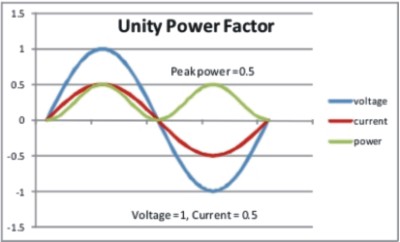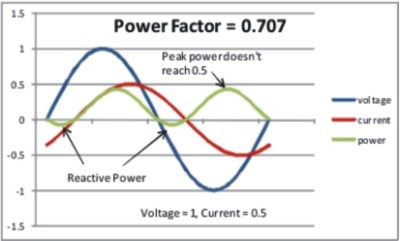
What is Power Factor?
The power you pay for is more complex than voltage times current as you probably learned in seventh grade science class. Our electrical grid runs on alternating current. Both the current and voltage constantly oscillate in wave form from wave peak to trough, once every 1/120 of a second. Ideally the voltage and current waves are in sync and “moving” the same direction at any given instant, and therefore the product of the two is always positive. See the Unity Power Factor chart.
If the voltage and current are not in sync and they do not peak and trough at the same time, the product of the two can be negative at times. This “negative” power is caused by what is referred to as reactive power which is not useful. It is stored in the device and returned to the grid on each cycle. When this occurs, the power factor is less than one. Power factor is defined as the real power divided by the apparent power (i.e., the sum of the real power plus the reactive power).

Why is a low power factor bad?
A low power factor is not desirable for you or for the utility. If your facility has a low power factor, the utility needs to supply more current than is necessary for the power you need (see the Power Factor chart). This means the utility needs to purchase larger equipment and will suffer more losses in delivering power to you.
Utilities pass these costs to customers that exhibit a poor power factor. While you are only charged for real power, a penalty is typically charged if your power factor drops below some predetermined value (0.95-0.85 in my experience.)
What causes low power factor?
There are a couple causes for low power factor. Usually they are related to inductive loads. In plain English, an inductive load can be motors, transformers, and magnetic lighting ballasts (e.g., older T12 lighting). Lightly loaded motors can be especially troublesome. Once they drop below 50% load the power factor tends to fall off quickly, more so for smaller motors. Electronics can also wreak havoc on your power factor with what are referred to as non-linear loads (current that doesn’t behave as smooth waves).
How can I fix a low power factor?
Power factor can be corrected. Replacing older lighting and installing properly sized motors may help the issue, but there is another approach that is typically employed, at the building or load level. Installing a bank of capacitors can help keep the power factor above a pre-determined level. Capacitors act to counter the reactive power, thus moving the power factor closer to one. However, if you have a high percentage of non-linear loads, you may need to do some power filtering before capacitors can be used. Regardless of what is causing your poor power factor, a qualified energy professional can help you find a solution.



